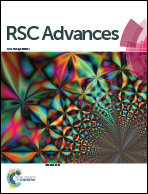Concentration dependent effect of CuCl2 on the photocatalytic degradation of phenol over anatase, rutile and brookite TiO2†
Abstract
Effect of Cu2+ ions on the TiO2-photocatalyzed degradation of organic pollutants in water has been reported in the literature, but the results are controversial. In this work, the effects of Cu2+ concentration, TiO2 structures, and light intensity have been re-investigated, by using phenol degradation in an acidic aqueous suspension as a model reaction. As the concentration of CuCl2 increased, the rates of phenol degradation over anatase, rutile, and brookite increased, and then decreased, but the reaction rate measured with P25 TiO2 always decreased. Such unusual behavior of P25 was also observed when CuCl2 was replaced with NaCl and MgCl2, ascribed to the salt-induced particle aggregation. In all cases, Cu+ species were formed, followed by reoxidation to Cu2+ by O2. However, at a high CuCl2 loading, metallic Cu was also detected, due to the competitive disproportionation of Cu+ ions. An open circuit potential measurement with anatase and P25 film electrodes revealed that the interfacial electron transfer from the irradiated TiO2 to Cu2+ was faster than that to O2. Furthermore, the reaction rate was proportional to light intensity. The relevant quantum yield of phenol degradation over rutile upon the addition of CuCl2 was increased by approximately 4 times.


 Please wait while we load your content...
Please wait while we load your content...